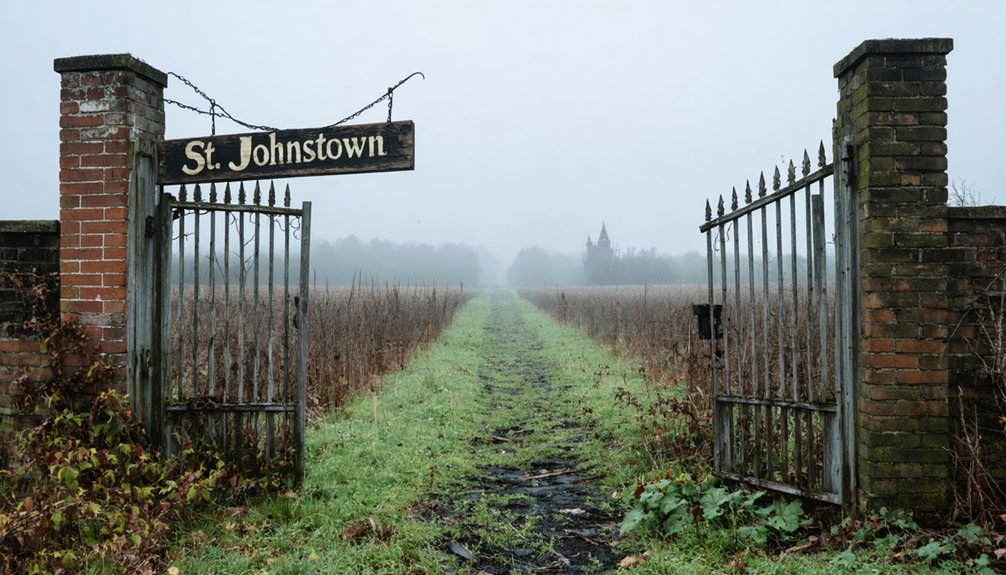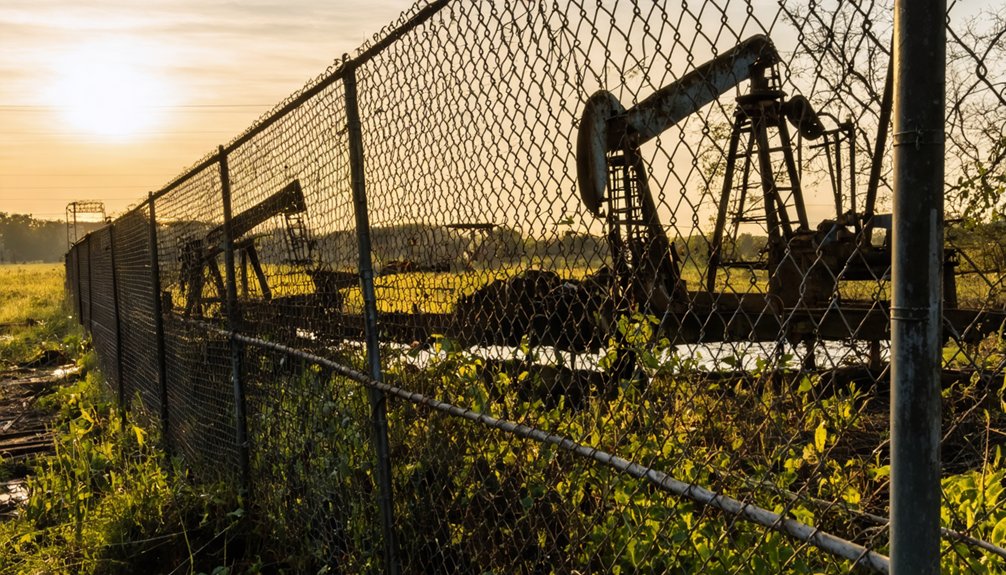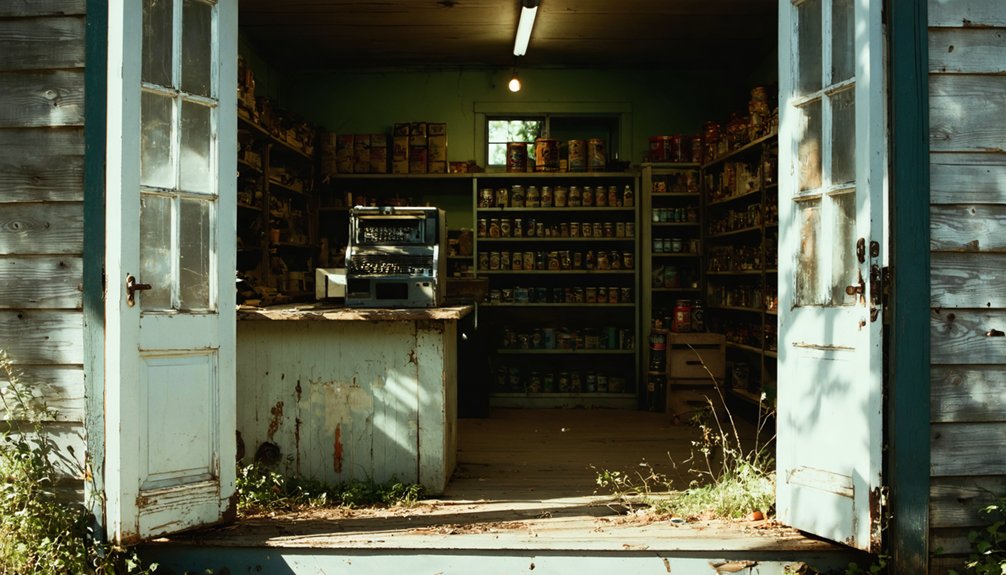Saint Johnstown, Delaware began as a thriving agricultural trading center in Sussex County, located less than a mile east of Greenwood. You’ll find it rose to prominence through the Queen Anne’s Railroad connection in the late 1800s, facilitating the transport of wheat, tobacco, and other agricultural goods. As railroad operations declined in the 1920s and Greenwood’s influence grew, Saint Johnstown’s businesses closed and residents departed. Today, only foundations and the Methodist Church remain, telling a deeper story of transportation’s impact on rural communities.
Key Takeaways
- Saint Johnstown was a small Delaware village that became a ghost town after being economically overshadowed by nearby Greenwood.
- The town thrived as an agricultural trading center but declined when the Queen Anne’s Railroad scaled back operations in the 1920s.
- Only the St. Johnstown Methodist Church remains as a significant structure, with other buildings reduced to archaeological foundations.
- Located less than a mile east of Greenwood, the site demonstrates how transportation changes can lead to community abandonment.
- The town’s demise resulted from residents migrating away for better opportunities after local businesses closed and services diminished.
The Rise and Fall of Saint Johnstown
Located less than a mile east of present-day Greenwood, Delaware, Saint Johnstown emerged as a small but notable village in Sussex County during its early development.
You’d have found a close-knit community connected by the Queen Anne’s Railroad line, which served as the village’s economic lifeline for transportation and commerce.
As nearby Greenwood grew in prominence, Saint Johnstown faced increasing challenges.
The village’s dependence on rail transport proved detrimental when railroad activity declined, triggering a pattern of economic migration.
Limited access to essential services like healthcare and education, coupled with stronger opportunities in surrounding towns, led to the community’s decline.
Some historic houses remain, including one with connections to the notorious slave trader Patty Cannon.
Local residents have reported seeing mysterious white spectral horsemen galloping through the abandoned streets at dusk.
Without the ability to diversify its economy or attract new residents, Saint Johnstown gradually transformed from a vibrant settlement into what’s now considered a ghost town.
Early Settlement and Railroad Connection
You’ll find that Saint Johnstown’s earliest development followed typical colonial settlement patterns until the Delaware Railroad’s arrival in 1858 transformed the community.
During its founding, the region was under Dutch control until 1664 when the English seized the territory.
Like many early Delaware County settlements, Dutch and Palatine German settlers moved into the area from Kingston seeking new opportunities.
The railroad’s completion near the town created new economic opportunities through improved transportation and trade connections to surrounding regions.
Saint Johnstown’s position along both older stagecoach routes and the new rail line initially strengthened its role as a transit hub, influencing local commerce and population growth in the pre-Civil War period.
Railroad’s Early Economic Impact
As the Delaware Railroad took shape in the mid-1800s, its development marked a transformative period for Sussex County’s economic landscape.
You’ll find that despite initial setbacks from the Depression of 1837-1839, the railroad’s expansion gained momentum after securing state investment in 1852. By 1856, the line stretched from Bear to Seaford, revolutionizing regional commerce.
The railroad’s economic transformation was immediate and far-reaching. You could see its impact in the birth of new commercial centers like Greenwood, which emerged in 1856 along the tracks. The railroad played a crucial role in the region’s agriculture, particularly in shipping peach crops that reached five million baskets by 1875. Like the Delaware & Hudson Railway’s success with anthracite coal, the Delaware Railroad became vital for transporting local resources.
While Greenwood flourished with diverse businesses, mills, and services by 1910, nearby Saint Johnstown faced decline after being bypassed. The rail connection opened broader markets for local goods, linking Sussex County to Philadelphia and other major northeastern trade hubs.
Original Settlement Development Pattern
Though its exact founding date remains uncertain, Saint Johnstown established itself as one of Delaware’s earliest colonial settlements before the American Revolution.
You’ll find evidence of its importance on ancient maps of the region, where it’s marked near present-day Greenwood, Delaware.
The settlement patterns followed typical colonial development, with early residents establishing farms and engaging in local trade.
You’d have seen agricultural practices that supported the community’s growth while fostering connections with nearby settlements and Native American tribes.
Similar to the Treaty of Fort Stanwix, early agreements with Native Americans in the region initially reduced frontier conflicts but were eventually broken.
The area’s settlers, like those under William Penn’s leadership, maintained peaceful relations with indigenous tribes during the early colonial period.
When the Delaware Railroad arrived in 1858, it transformed Saint Johnstown’s economic landscape by creating new transportation routes and trading opportunities.
This rail connection reshaped the settlement’s development, though it couldn’t prevent the town’s eventual decline into what’s now considered a ghost town.
Queen Anne’s Line Influence
The Queen Anne’s Railroad transformed Saint Johnstown’s regional connectivity when it incorporated in 1894 and received Delaware legislative authorization to extend its lines in February 1895. The railroad expansion established essential links between Baltimore and the Delaware coast, offering both passenger and freight services that boosted the local economy.
You’ll find that the railroad’s influence peaked during the early 1900s, connecting Saint Johnstown to major transport hubs through its eastern terminus in Lewes and western terminus in Queenstown. Regular passenger and mail service operations were inaugurated following the construction of a new station in October 1897. The popular Cape May Express began seasonal operations in 1901, further enhancing the region’s transportation options.
The line’s completion in 1898 created new opportunities for community connectivity, allowing residents to ship various goods, including seasonal greenery and holly.
When the Pennsylvania Railroad acquired the line in 1905, it maintained these critical connections until declining profits in the 1920s led to the gradual abandonment of services.
Economic Activities in the Golden Years
Saint Johnstown’s prime location along the Queen Anne’s Railroad line transformed it into a bustling commerce hub where you’d find freight and passenger services supporting the movement of agricultural goods and manufactured products.
You could see the town’s merchants taking advantage of rail connections to import lumber, hardware, and consumer goods while exporting local farm produce and livestock.
The railroad’s presence directly fueled Saint Johnstown’s economic growth by enabling local stores to maintain diverse inventories and facilitating trade connections with nearby communities like Greenwood.
Railroad Commerce Hub
Located strategically along the Queen Anne’s Railroad line between Ellendale and Greenwood, Delaware, Saint Johnstown emerged as an essential railroad commerce hub during its peak years.
You’d find a bustling freight logistics operation moving coal, lumber, and manufactured goods through the town’s rail junction, connecting to the broader Delaware and Pennsylvania Railroad networks.
The station’s passenger services weren’t just for locals – they connected workers to jobs and linked rural Sussex County communities to larger economic centers. You could catch regular trains to nearby towns, making Saint Johnstown a significant connection point for both commerce and community life.
This golden age of rail wouldn’t last forever, though. As highways improved and automobiles gained popularity, the railroad’s importance declined, eventually leading to abandoned tracks and Saint Johnstown’s fade into history.
Agricultural Trading Center
During its golden years, Saint Johnstown thrived as one of Delaware’s premier agricultural trading hubs, where farmers brought abundant harvests of soft red wheat, tobacco, and various grains for processing and export.
You’d find bustling flour mills along the waterways, where Oliver Evans’ agricultural innovations revolutionized grain processing efficiency. The town’s merchants played an essential role in crop diversification, encouraging farmers to shift from tobacco to more profitable wheat production by the 1770s.
You could’ve witnessed Conestoga wagons loaded with produce making their way to Philadelphia’s markets, while local canneries preserved the season’s vegetables for wider distribution.
The town’s prosperity grew as its strategic location and processing facilities helped farmers convert from subsistence agriculture to commercial farming, establishing critical trade networks that would shape Delaware’s economic future.
Saint Johnstown’s Relationship With Greenwood

While establishing itself as a bustling railroad stop on the Queen Anne’s line, Saint Johnstown shared an intimate connection with the growing village of Greenwood, situated less than a mile to its east.
These historical connections shaped the region’s development, as both communities initially thrived from the railroad’s presence. However, when the railway ceased operations, you’ll find that Greenwood emerged as the dominant business center while Saint Johnstown gradually faded away.
Today, you can trace this relationship through local cultural heritage markers, including Saint Johnstown Road, which marks the historical boundary between the two settlements.
The area’s elevation of 52 feet and flat coastal plain geography made it ideal for both communities to develop agricultural trade, though Greenwood ultimately proved more resilient to changing times.
Impact of Transportation Changes
As Queen Anne’s Railroad began scaling back operations between Ellendale and Greenwood, Saint Johnstown faced a devastating blow to its economic foundation. The transportation evolution away from rail dependency proved fatal for this small community, as businesses that relied on railway shipping were forced to close or relocate.
You’ll find that the infrastructure decline created a domino effect throughout Saint Johnstown. Without adequate road networks to replace the defunct rail line, the town couldn’t adapt to the rising dominance of automobile travel.
While nearby Greenwood thrived with its dual rail lines and later highway connections, Saint Johnstown’s isolation deepened. The lack of transportation options triggered an exodus of residents seeking better opportunities, leading to the shutdown of local services and, ultimately, the town’s complete abandonment.
Natural Resources and Environmental Factors

The rich natural resources that initially attracted settlers to Saint Johnstown ultimately played a role in its downfall. The town’s early prosperity relied on abundant forests and fertile soil, supporting logging and farming operations that sustained the community.
However, resource depletion gradually undermined Saint Johnstown’s environmental sustainability. Years of intensive agriculture led to soil exhaustion, while deforestation altered local ecosystems and reduced available timber.
You can trace the town’s decline through these environmental changes, as flooding and storms in low-lying Sussex County further stressed the vulnerable settlement.
Without major waterways for trade or mineral deposits for economic diversification, Saint Johnstown couldn’t overcome its dwindling natural resources.
Today, nature has reclaimed the abandoned town, with forest regrowth and natural succession transforming former farmlands into rewilded spaces.
Archaeological Remnants and Historical Sites
Despite decades of decay, Saint Johnstown’s archaeological footprint reveals scattered remnants of its railroad-era past. Archaeological findings are limited to foundations and rail bed traces from the Queen Anne’s Railroad era, with no significant prehistoric artifacts discovered at the site.
You’ll find the St. Johnstown Methodist Church, situated about a mile east of Greenwood on Old King’s Highway, stands as the most prominent surviving structure. It’s one of the few remaining 19th-century buildings connected to the ghost town.
While historical preservation efforts have been minimal, with no formal markers at the site, local historical societies maintain records of the town’s heritage. Dutch bricks and charred structural remains, similar to those found in nearby ghost towns, hint at moments of conflict in early Delaware settlements.
Life in a Delaware Ghost Town

Life in Saint Johnstown revolved around the Queen Anne’s Railroad, which served as both the town’s economic lifeline and social nucleus during the early 1900s.
You’d find residents gathering at the depot, general stores, and churches, where daily rituals of commerce and conversation unfolded. Local families earned their living through railroad work, agriculture, and small businesses like lumber mills and livery stables.
Your home would’ve been a simple wooden structure, heated by wood stoves, with water drawn from wells.
Community gatherings at the Saint Johnstown Church strengthened social bonds among the mainly European-descent population.
As railroad traffic declined and transport routes shifted, you’d have witnessed the town’s gradual emptying, with younger residents moving to urban areas, leaving behind aging neighbors and deteriorating infrastructure.
Legacy of Saint Johnstown Today
Modern visitors to Saint Johnstown‘s former location will find no trace of this once-bustling Delaware railroad stop, as farmland has completely reclaimed the site less than a mile east of present-day Greenwood.
Unlike other Delaware ghost towns that maintain physical remnants or historical markers, Saint Johnstown’s community heritage exists primarily in brief mentions within local history books and online databases.
You won’t find dedicated museum exhibits or interpretive displays here – the site’s historical significance has faded with time.
While specialists and ghost town enthusiasts occasionally reference Saint Johnstown in their research, it lacks the archaeological context and preservation efforts seen at sites like Zwaanendael.
Today, the ghost town serves as a quiet reminder of rural Delaware’s evolving settlement patterns, though without any monuments or structures to mark its former existence.
Frequently Asked Questions
Are There Any Remaining Structures or Buildings in Saint Johnstown Today?
Like over 130 Delaware ghost towns, you won’t find any remaining buildings or ghostly remnants in the area today – everything’s been reclaimed by nature or private landowners without preservation.
What Happened to the Original Residents When Saint Johnstown Was Abandoned?
The original residents slowly left this ghost town, moving to nearby Greenwood and other railroad hubs. You’ll find their descendants scattered across Delaware, having relocated for better economic opportunities.
Were There Any Notable Crimes or Mysteries Associated With Saint Johnstown?
You won’t find any documented unsolved disappearances or criminal activities from Saint Johnstown. Historical records, local folklore, and archaeological evidence don’t reveal any notable mysteries or crimes from this small railroad stop.
Did Any Famous People or Historical Figures Live in Saint Johnstown?
You won’t find any famous residents in historical records from this location. While the town held local historical significance during its railroad days, no notable figures are documented as living there.
What Was the Peak Population of Saint Johnstown Before Its Decline?
All good things must end. You’d find no exact records exist, but based on population trends and demographic shifts of similar railroad towns, it likely peaked between 100-300 residents before declining.
References
- https://www.youtube.com/watch?v=ex8Hld_imPU
- https://delawaretoday.com/things-to-do/haunted-places-delaware/
- https://en.wikipedia.org/wiki/List_of_ghost_towns_in_Delaware
- https://anabasis.fandom.com/wiki/Saint_Johnstown_(Delaware)
- https://greenwood.delaware.gov/about-the-history-of-greenwood/
- https://www.visitkeweenaw.com/listing/delaware-the-ghost-town/515/
- https://kids.kiddle.co/List_of_ghost_towns_in_Delaware
- http://freepages.rootsweb.com/~gtusa/history/usa/de.htm
- https://www.youtube.com/watch?v=4HxywnmIKSY
- https://www.dcnyhistory.org/books/murraysectionIII.html



